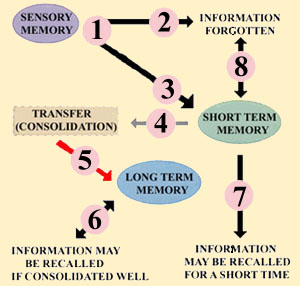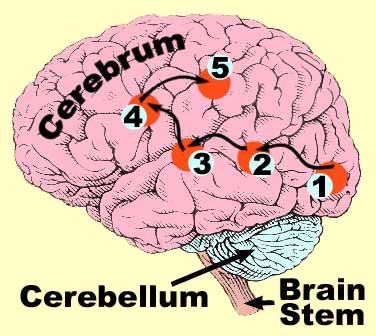This flow chart can help you visualize the complex memorization process -- if you choose to use it:

SIMPLIFIED MEMORY PROCESS
FOR CLEARER UNDERSTANDING
-
Sensory memory
- Information forgotten
- Short term memory
- Transfer (consolidation)
- Long term memory due to repetition and reasoning
- Information recalled if consolidated well as long term memory
- Information recalled for a short time since it was not consolidated
- Information forgotten if not repeated or associated with other memories
[3] DOUBLING YOUR MEMORY POWER
1) INSTANT MEMORY
[1] Five steps to instant memory:
(1) You can "tag" the information with a "mental charge," which lifts the information above other data and ensures your conscious mind will be able to
locate it quickly and easily whenever you need to recall it!
(2) These five simple words can help you consciously "tag" critical new information so it will be remembered longer!
They are BELIEVE --- INTEND ---
VISUALIZE --- COMMAND --- REVIEW!
The FIVE "FOOLPROOF" STEPS to "instant memory" are:
Step One = BELIEVE you will remember the material, which energizes your brain for remembering!
Step Two = INTEND to remember the material by putting your genuine willpower into an effort that doubles your chances for success!
Step Three = VISUALIZE or repeat the material once clearly in your mind!
Step Four = COMMAND by consciously telling yourself to remember the material!
Step Five = REVIEW your memory of the material the next day!
In addition, you can recall what you missed with "instant replay" and
capture complex details forever with "mental review!"
Also, you can forget what you do not need to remember with "memory delete"
Your "power memory" can be improved by using "mnemonic techniques" and "memory maps," which personalize your efforts in order to improve your memory skills.
For truly successful and fulfilling quick and efficient learning, you need to think about planned repetition of the five steps or techniques of "instant memory" by thinking about remembering whatever you want to memorize in a more complex creative way.
[2] Recall what you missed with "instant replay"
[3] Capture complex details forever with "mental review"
[4] Forget what you do not need with "memory delete"
2) POWER MEMORY --- using "mnemonic techniques"
3) MEMORY MAPS --- the power of "personalizing"
Book source: (Double Your Brain Power)
[4] LEARNING THE THREE ESSENTIAL MEMORY SKILLS ---
LOOK, SNAP & CONNECT!
When a "nerve impulse" passes through a cell in your brain or nervous system sending an electrical charge or message, the chemistry of the cell itself changes.
As you learn a new idea, the new electrical pathways that are initially created enable you to remember that new idea for a few minutes. To remember an idea for a longer period of time, you must pay close attention to it and consciously think about it many more times in order to make your memory process more efficient.
Thus the information you want to remember must be repeated many times or be interesting to you --- so you will consciously "associate" it with something else that is already in your memory.
A proven method of effectively improving your memory involves training yourself to accomplish three basic skills:
LOOK,
SNAP, and
CONNECT!
These three memory skills can be easily learned:
(1) LOOK --- Actively observe what you want to learn!
Slow down, take notice, and focus on what you want to remember. Consciously absorb details and meaning from a new face, event or conversation.
(2) SNAP --- Create mental "snapshots" of memories!
Create a "mental snapshot" of the visual information you wish to remember. Add details to give the "snaps" personal meaning and make them easier to learn and recall later.
(3) CONNECT --- Link your "mental snapshots" together!
Associate the "images-to-be-remembered" in a chain, starting with the first image, which is associated with the second, the second with the third, and so forth. Be sure the first image helps you recall the reason for remembering the chain.
If you use these three simple memory skills, the idea or thing that you want to remember will truly become a part of you since a permanent physical-chemical change takes place in your brain cells through the process of "spaced repetition" or by pure reasoning.
Book source: (The Memory Bible)
[5] YOU CAN UNDERSTAND HOW YOUR BRAIN REMEMBERS THINGS
How does your memory work and why is it so important for your future success?
Life without your memory would be impossible! You need it to remember who you are, how to walk, how to speak, and whether or not you like something. In fact, it is your memory that makes you who and what you are!
[1] Your long-term memory stores everything you know! It has a limitless capacity.
[2] Short-term memory
Your short-term memory can only store a maximum of NINE THINGS at one time and most people can store only SEVEN THINGS at a time!
[3] Storage
(1) You can store different sorts of information in your memory in different ways!
(2) Most facts in your short-term memory are stored as sounds!
[4] What are memories?
(1) Everything you learn and all your experiences are "encoded" in your brain as patterns of electrical pulses passing between neurons!
(2) Thus memories are patterns of pulses that are repeated without the experience actually taking place!
[7] Remembering
(1) Loony lists
(2) Short-term memory test
You can get more in your short-term memory if you can "group" the facts
you have to store into bigger units!
Book source: (Understanding Your Brain)
[6] MEMORY PRESCRIPTION AND TESTS
Although the initial 14 days of the "Memory Prescription" program is enough time to jump-start your brain and body into new healthy habits, most people are so pleased with their initial results that they decide to stick with the program for months and years.
How do you rate your current mental and physical fitness level?
1) Assessing memory ability
2) Rate your subjective memory ability
Subjective memory questionnaire
3) Assess your objective memory ability
Objective memory assessment #1
4) Are you stressed out?
[1] Update your objective memory assessment score
[2] Assessing your subjective memory ability
Subjective memory questionnaire
[3] Reassess your stress level
Stress level questionnaire
[4] Reassess your level of physical fitness
Physical fitness questionnaire
[5] Weighing in on Day 14
[6] Primed and Ready
Stress level questionnaire
[5] Assess your level of physical fitness
[6] The memory prescription diet
(1) Ideal body weights for women
(2) Ideal body weights for men
[7] Following your progress --- charting baselines for setting goals
The 14-day memory prescription
Your 2-week checkup --- gauge your success
Book source: (Memory Prescription)
[7] MEMORY POWER
1) THE PHYSICAL BASIS OF MEMORY
2) HOW DO MEMORIES RELATE TO THE STRUCTURE OF YOUR HUMAN BRAIN?
3) MEMORY IS A VERY COMPLEX SYSTEM OF ELECTRO-CHEMICAL PROCESSES:
4) WORKOUTS AND TESTS TO IMPROVE YOUR MEMORY
Because of scientific research on damage to small parts of the brain that interfere with memory while damage to other parts does not, we now know:
(#1) That no single structure or part is responsible for memory; and
(#2) That the hippocampus, which lies within the temporal lobe and the frontal lobe, are both involved in memory formation; and
(#3) Memories are encoded in long-term memory by chemical changes in specific neurons; and
(#4) That new memories are formed by the growth of new synapses. Research suggests
#5) That short-term and long-term memory processes are independent of each other; and
(#6) That information does not necessarily have to be in short-term memory before it transfers to long-term memory storage. (p88-90)
LOOK AT THE BRAIN IMAGE FEATURING THE BRAIN AREAS ESSENTIAL FOR MEMORY PROCESSES:
1. Parietal lobe
2. Frontal lobe
3. Occipital lobe
4. Temporal lobe
5. Hippocampus
6. Cerebellum
TECHNIQUES FOR IMPROVING MEMORY
[1] External memory aids
[2] Internal memory aids
[3] General rules for memory
(1) Attention and concentration
(2) Organizing material
(3) Repetition and practice
[4] Tips for recall
[5] Mnemonic systems
(1) Visual mnemonics
(2) Verbal mnemonics
Book source: (Memory Power)
[8] TEN SIMPLE THINGS
YOU CAN DO TO IMPROVE YOUR MEMORY
Ten steps to a good memory (p2-4)
[1] Gain an understanding of how your memory works
[2] Develop memory tools to assist you
[3] Find the motivation and make a commitment
[4] Enjoy life and continue to grow as a human being
[5] Increase your ability to focus on what's at hand
(1) Increase your effective use of memory aids
(2) Develop better habits of attention and concentration
(3) Focus on one thing at a time and set your own pace
(4) Be aware of your distracting emotions
(5) Be open to new ideas
[6] Organize both how you learn and how you live
[7] Take care of your health
[8] Deal with stress and depression
[9] Understand and cope with the natural aging process
[10] Become your own mentor in support of your memory-improvement program.
Book source: (The Memory Manual)
[9] HOW YOUR MEMORY WORKS & HOW TO IMPROVE IT
Book source: (Your Memory --- How It Works & How to Improve It)
[10] TEN SIMPLE THINGS YOU CAN DO TO IMPROVE YOUR MEMORY
Book source: (Your Memory --- a User's Guide)
[11] OPTIMAL MEMORY
Book source:
(The Harvard Medical School Guide to Achieving Optimal Memory)
Return to:
Fast Memorization Method
Return to Essay-Set #1:
Focus on the Self-Liberation Philosophy
Return to Essay-Set #2:
Focus on Your Creative Change Strategy
Go to the Interactive Index: Brainpower Index of Factual Ideas
|

